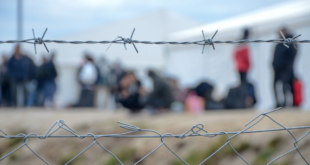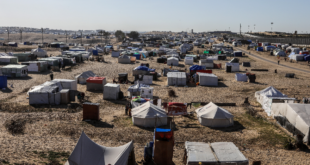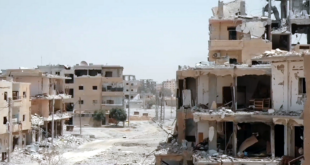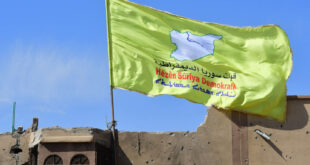Suspected drone attacks on key oil installations in Saudi Arabia have rattled world energy markets, spiked regional tensions, and provoked threats of military action by the United States.
The September 14 attacks have disrupted about half of Saudi Arabia’s oil production — or roughly 5 percent of global supplies — the biggest disruption to world crude supplies ever.
The Huthis, the Iran-backed rebel group that has been fighting a Saudi-led military coalition in neighboring Yemen since 2015, claimed responsibility for the attacks. But the United States, a key Saudi ally, has blamed Iran and warned it could retaliate. Tehran has rejected any involvement.
Days after the attacks, the picture surrounding the incidents remains murky, with key questions unanswered.
Who Carried Out The Attacks?
The United States has released satellite images and cited intelligence that it said indicated Iran was behind the attacks.
Saudi Arabia said the weapons used for the attacks on the Abqaiq oil-processing facility and the expansive Khurais oil field “came from Iran,” although it said it was probing “from where they were fired.”
Unnamed U.S. officials said satellite photos showed 19 points of impact at several facilities that they said came from the north and northwest — from the direction of Iran or Iraq — not from Huthi-held territory in Yemen. But the satellite images did not appear clear cut. Some appeared to show damage on the western side of the facilities, not from the direction of Iran or Iraq, where pro-Iranian militias are present.
No smoking gun has been found.
“The way Iran operates through proxy groups you aren’t going to have a definitive, conclusive piece of proof that it was Iran that carried out the launches itself,” said Scott Lucas, an Iran expert at Birmingham University in Britain and editor of the EA World View website.
Iran has proxies throughout the region, including Lebanon’s Hizballah, Shi’ite militias in Iraq, and the Huthis in Yemen.
Ali Vaez, the Iran project director at the International Crisis Group (ICG), said plausible deniability has been the trademark of Iran’s push-back strategy against the United States — from attacks on U.S. forces in Iraq after the invasion in 2003 to attacks against shipping in the Persian Gulf this year.
“So, while not impossible, it is implausible that the attack originated from Iran,” he said. “If the evidence points to direct Iranian involvement, it would constitute an unprecedented escalation.”
Were The Huthis Capable Of Launching The Attacks?
Unnamed U.S. officials said a combination of drones and cruise missiles might have been used in the attacks. They suggested the Huthis could not carry out an attack with such scope, precision, and sophistication by themselves.
A Huthi spokesman said the major assault was carried out by 10 drones.
The Huthis have acquired much more sophisticated weaponry, including extended-range drones, extended-range short-range ballistic missiles, anti-ship cruise missiles, and waterborne improvised explosive devices, according to the United Nations, which added that the rebel group was able to strike targets up to 1,500 kilometers away.
This year, the Huthis have claimed responsibility for drone attacks on Saudi oil installations, airports, power stations, and tankers. The group has also claimed attacks in the neighboring United Arab Emirates.
Independent intelligence analysts said the Huthis have received training inside Iran and drone and missile technology from Tehran.
“It is not a question of either Huthi or Iranian capability but it’s the fact that the two have worked together to develop a capability,” said Lucas. “So, if this attack came from Yemen, it would probably be a combination of the Huthis and the Iranians as the actors behind it.”
Why Would Iran Risk Such A Confrontation?
If Iran or one of its proxies carried out the attacks in Saudi Arabia, it would fit a strategy that Tehran has pursued for months in its escalating confrontation with the United States, analysts said.
In July, Washington said a U.S. Navy ship destroyed an Iranian drone in the Strait of Hormuz after it was threatened. Iran denied it lost a drone.
In June, Iran shot down a U.S. surveillance drone in the Persian Gulf. That incident prompted U.S. President Donald Trump to order U.S. forces to prepare for a retaliatory air strike against Iran that was called off at the last minute.
In May, four ships, including two Saudi oil tankers, were attacked in the Persian Gulf. U.S. officials blamed Iran, a charge Tehran rejected.
There was a sharp uptick in tensions between Washington and Tehran when Trump last year pulled the United States out of a landmark agreement between world powers and Iran in which Tehran accepted curbs on its nuclear program in exchange for relief from international sanctions.
Washington has reimposed harsh economic sanctions that have crippled Iran’s economy and slashed Tehran’s vital oil sales by at least 80 percent through what the United States is calling a “maximum pressure” campaign.
European signatories to the 2015 nuclear agreement have tried to salvage the deal by offering Iran financial relief. Trump has also said he is open to a face-to-face meeting with Iranian President Hassan Rohani and willing to negotiate a new agreement with the Islamic republic.
But Iranian officials have repeatedly said that the stifling sanctions must be removed before any talks can take place.
“The attacks [in Saudi Arabia] mark a logical and expected escalation in systematic provocations of the Islamic republic meant to improve Tehran’s negotiating position vis-a-vis the U.S.,” said Ali Alfoneh, a nonresident senior fellow at The Atlantic Council in Washington.
Vaez said the current escalation is the outcome of Washington’s maximum pressure strategy.
“If Tehran was indeed behind the attack, it is trying to impose a cost on the U.S. and its allies for inflicting maximum harm on the Iranian economy,” he said. “These attacks clearly demonstrate that the strategy of bombing the Yemenis and starving the Iranians into submission is more likely to backfire than to bring the intended policy results.”
Vaez said Iran, and the Huthis, have increasingly less to lose and seem to have become increasingly less risk averse.
Will The United States Attack Iran In Retaliation?
Trump said on September 16 that it was increasingly “looking like” Iran was behind the attack on Saudi Arabian oil facilities, but said it was still too early to be sure.
He also said the United States doesn’t want war but was ready to help the country’s key ally in the Gulf region counter the attack once a “definitive” determination is made on who was responsible.
“If Saudi Arabia accepts U.S. intelligence reports and holds Iran directly responsible, there is a risk of Saudi involvement in the fight between Iran and the U.S.,” said Alfoneh. “There is a risk of war.”
Vaez said any retaliation against Iran is likely to prompt an Iranian counterattack that in turn risks inflaming the entire region.
“The solution is not to further escalate, but to capitalize on [Europe’s] initiative to de-escalate tensions between Tehran and Washington,” he said.
 Eurasia Press & News
Eurasia Press & News



